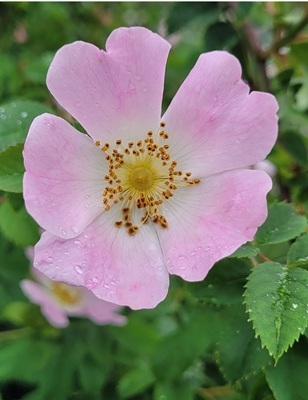Flower Properties
| Property | Value |
|---|---|
| English Name | Dog Rose |
| MainColor | Pink |
| PlantType | |
| Growth Type | |
| Season | May |
| ImageUrl | Rosa-003 |
| Photographer | DP |
| Location | |
| Human Toxicity | Non_Toxic |
Flower Details
Description
The dog rose is a scrambling wild rose found in hedgerows, woodland edges, and countryside across the UK. It has delicate, pale pink to white flowers with five petals and bright orange-red hips in autumn. Its arching, thorny stems can form impenetrable thickets.
Distribution
Native to Europe, including the UK, the dog rose is common throughout the British Isles. It’s an important part of traditional hedgerows and provides habitat and food for wildlife.
Medicinal/Other Uses

Dog rose hips have been used for centuries in folk medicine. They are particularly rich in vitamin C, and herbal preparations are used to support immunity and ease joint pain. Rose hip extracts are now sold as supplements for osteoarthritis and general wellness.
Edibility

The hips are edible once the seeds and hairs inside are removed. They can be made into syrups, jellies, and teas. The flowers are sometimes used in perfumery or flavouring, but less commonly than other roses.
Human Toxicity
The fine hairs inside rose hips can irritate the mouth or digestive tract if not removed. Always strain rose hip preparations before use. Those with pollen allergies may be sensitive to the flowers.
Pet Toxicity
Not Toxic
Active Compounds
Rose hips are rich in vitamin C, carotenoids, flavonoids, and tannins. They also contain galactolipids and polyphenols, which may contribute to anti-inflammatory effects.
